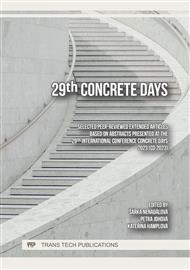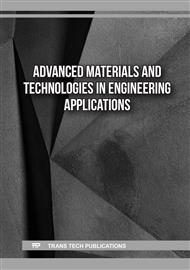p.3
p.11
p.17
p.25
p.31
p.39
p.45
p.53
3D Printed Cement Composites Testing
Abstract:
Testing of the properties of cement mortars for 3D printing has not been standardized yet. Manufacturers of dry mixes declares tensile strength and compressive strength, but these properties are determined on standard beams for cement mortars, and their values may differ from the material actually formed by the 3D printing method. Another factor affecting strength is the printing process itself, where different printing machines require different consistencies and therefore different amount of water. Last but not least, it is necessary to take into account the different properties of the printed material depending on the direction of testing. Presented article brings results of determination the compressive strength, flexural tensile strength, splitting tensile strength and uniaxial tensile strength of the cement mortar from 3D printing loaded in different directions in relation to the axis of the print and comparing them with the parameters determined on standard beams made of the same material. A commercially produced dry mixture was used. Rectangular object was printed. Before the actual printing and also the fresh mixture was taken from the print head directly into the molds for the production of standard beams 40×40×160 mm. The printed object and the beams were placed in a water environment after 24 hours and the properties were determined at the age of 28 days. Cubes with dimensions of 40×40×40 mm and beams of 40×40×160 mm were subsequently cut from the printed object. The results of the testing point to a relatively large variability of the strength characteristics not only according to the direction of the load forces, but also in different places of the printed object (samples were taken in the bottom part, in the middle and in top of the printed object). Strengths of the standard beams were significantly higher than strengths of samples cut out from 3D printed object.
Info:
Periodical:
Pages:
17-24
Citation:
Online since:
March 2024
Authors:
Price:
Сopyright:
© 2024 Trans Tech Publications Ltd. All Rights Reserved
Share:
Citation:



